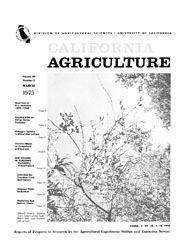


University of California
California Agriculture
|
|||
|
|||

Cover:
Almond branch showing severe failure of leaf buds; flower buds have bloomed and set fruit.
March 1975
Volume 29, Number 3 News and opinion |
|||
|
University of California, 1301 S. 46th St., Bldg. 478 Richmond, CA
|